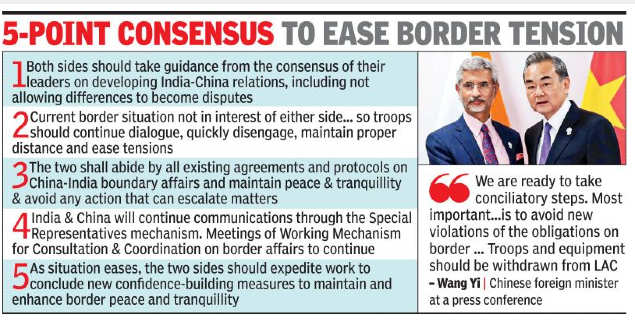
[ad_1]
The points were spelled out in a joint statement and while the test, so far as India is concerned, lies in Chinese troops pulling back on the ground, Chinese foreign minister Wang Yi‘s comments in Moscow on Friday offer hope of forward movement. “We are ready to take conciliatory steps… The most important thing is to avoid new violations of the obligations on the border. Troops and equipment should be withdrawn from the Line of Actual Control,” Wang said during a press conference with Russian foreign minister Sergey Lavrov, according to an ANI report.

With India-China discussions distilling into a joint statement, there was expectation that the in-person meeting between foreign minister S Jaishankar and Wang might yield results that could restart the stalled disengagement, which has heightened hostilities and tensions with troops within a few hundred metres of each other at several place on the LAC. Ahead of the meeting, Indian forces had taken charge of key heights in the Pangong Tso area, giving the Indian side crucial leverage in the discussions that took place in Moscow.
The statement said the two sides shall avoid any action that escalates matters, and abide by all existing agreements and protocol on China-India boundary affairs, besides maintaining peace and tranquillity in the border areas. It also noted that once the situation eases, the two sides should expedite work to conclude “new confidence-building measures” to maintain calm along the border.
The political understanding reached in Moscow will now have to be translated on the ground by negotiations between military commanders of both sides who are to work out the nitty-gritty and verification. The discussion on Thursday evening was often heated, described in diplomatic parlance as “frank and constructive”. The substance of the outcome was that the two sides hammered out the broad contours of a disengagement process, a result that had eluded the two sides.
This would be easier for the Indian side to accomplish than the Chinese, considering that, as seen during the Doklam crisis, the foreign ministry in Beijing and the PLA had differing perceptions. However, given that a joint statement has been arrived at, Wang could be expected to be working on a brief cleared by the top Communist Party leadership.
Meanwhile, the two armies remain in stand-off positions in different areas along the LAC, primarily on the northern and southern banks of Pangong Tso. Since late August, when the Indian Army acquired some tactical advantages on the Ladakh heights, the Chinese army has been relentless in trying to dislodge the Indian troops.
The joint statement said, “The two sides also agreed to continue to have dialogue and communication through the special representative mechanism on the India-China boundary question. They also agreed in this context that the working mechanism for consultation and coordination on India-China border affairs (WMCC) should also continue its meetings.” In recent weeks, both the military commanders’ meetings and the WMCC have been inconclusive, with no agreement on disengagement.
The transgressions across the LAC, the unusually high build-up of troops and the violence over the past few months have virtually buried all existing agreements, something that has been repeatedly referred to by both sides in angry statements. The reaffirmation of the existing agreements is expected to see the two countries through the current crisis as the ministers agreed that fresh border management agreements and new CBMs would have to be crafted.
[ad_2]
Source link